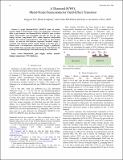| dc.contributor.author | Yin, Zongyou | |
| dc.contributor.author | Tordjman, Moshe | |
| dc.contributor.author | Vardi, Alon | |
| dc.contributor.author | Kalish, Rafi | |
| dc.contributor.author | del Alamo, Jesus A | |
| dc.date.accessioned | 2020-07-14T16:10:56Z | |
| dc.date.available | 2020-07-14T16:10:56Z | |
| dc.date.issued | 2018-02 | |
| dc.identifier.issn | 0741-3106 | |
| dc.identifier.issn | 1558-0563 | |
| dc.identifier.uri | https://hdl.handle.net/1721.1/126179 | |
| dc.description.abstract | A p-type Diamond:H/WO 3 metal-oxide-semiconductor field-effect transistor (MOSFET) based on surface transfer doping is demonstrated. Using a low-temperature ALD-grown HfO 2 as gate insulator, the Diamond:H/WO 3 MOSFETs show excellent output characteristics, gate-controllable 2-D hole gas, and low gate leakage current. Long-channel FETs exhibit improved subthreshold behavior but reduced transconductance with respect to short-channel devices. An observed WO 3 -thickness-dependent threshold voltage is consistent with enhanced surface transfer doping as the WO 3 layer is thinned down. Low-temperature measurements suggest a significantly lower mobility than expected in this material system. This illustrates the challenge of maintaining high TMO quality during device fabrication. | en_US |
| dc.publisher | Institute of Electrical and Electronics Engineers (IEEE) | en_US |
| dc.relation.isversionof | http://dx.doi.org/10.1109/led.2018.2808463 | en_US |
| dc.rights | Creative Commons Attribution-Noncommercial-Share Alike | en_US |
| dc.rights.uri | http://creativecommons.org/licenses/by-nc-sa/4.0/ | en_US |
| dc.source | Prof. del Alamo via Phoebe Ayers | en_US |
| dc.title | A Diamond:H/WO3 Metal–Oxide–Semiconductor Field-Effect Transistor | en_US |
| dc.type | Article | en_US |
| dc.identifier.citation | Yin, Zongyou et al. "A Diamond:H/WO3 Metal–Oxide–Semiconductor Field-Effect Transistor." IEEE Electron Device Letters 39, 4 (February 2018): 540 - 543 © 2018 IEEE | en_US |
| dc.contributor.department | Massachusetts Institute of Technology. Microsystems Technology Laboratories | en_US |
| dc.contributor.department | Massachusetts Institute of Technology. Department of Electrical Engineering and Computer Science | en_US |
| dc.relation.journal | IEEE Electron Device Letters | en_US |
| dc.eprint.version | Author's final manuscript | en_US |
| dc.type.uri | http://purl.org/eprint/type/JournalArticle | en_US |
| eprint.status | http://purl.org/eprint/status/PeerReviewed | en_US |
| dspace.date.submission | 2020-07-09T19:43:15Z | |
| mit.journal.volume | 39 | en_US |
| mit.journal.issue | 4 | en_US |
| mit.license | OPEN_ACCESS_POLICY | |
| mit.metadata.status | Complete | |
